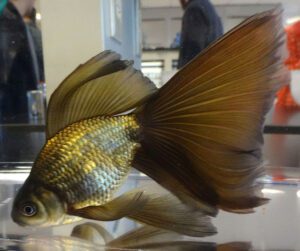The Telescope goldfish is a breed of fancy goldfish which is easily characterized by it’s protruding eyes. It is believed to have been first developed in China in the early 1700s (when they were named the Dragonfish or the Dragon Eye Goldfish). Later they were given the name Demekin in Japan. And the Japanese still call them as Demekin. The Telescope goldfish is probably the most heavily hybridized goldfish variety after the Fantail. However read some more information about this goldfish variety below.
Telescope Goldfish Characteristics
The Telescope goldfish is one of the more rounded or egg-shaped fancy goldfish variety. It is similar to the Fantail Goldfish variety, except for it’s telescoping eyes and slightly smaller size. Body of these fish is short and stubby with a very wide head and a split caudal fin that is moderate in length and slightly forked. Currently these fish are also available with long flowing fins and a couple other tail fin styles.
The Telescope goldfish are available in many different colors in both nacreous and metallic scale types. But they seldom appear in a matte scale type. Common coloration of these fish include solid of red, chocolate, blue or white; tri-colored and calico; and bi-colored versions in red/white and black/white. Average body length of the mature Telescope goldfish is between 4 and 6 inches. But they can also reach between 6 and 8 inches.[1].

Diet
The Telescope goldfish are omnivorous and they will eat almost all types of foods. They can eat vegetables and also live foods. They can be feed on all kinds of fresh, frozen and flake foods.
Breeding
The Telescope goldfish belongs to the scattered egg reproduction type. They have a definite courtship ritual, so they can be breed easily. The females can lay up to 1,000 eggs per spawning, and the fry hatches within 5 to 6 days.
Uses
The Telescope goldfish are ornamental fish species. They are also raised as pets.
Special Notes
The Telescope goldfish should not be mixed with more active goldfish varieties, mainly due to their poor vision. They should also not to be housed in an aquarium with sharp or pointed objects. They are pretty long lived fish and can live between 15 and 20 years. Like many other goldfish varieties, the Telescope goldfish are very social and generally thrive in a community. Currently there are some variants of these fish are available such as Black Telescopes, White Telescopes, Panda Telescopes and there are also red, yellow and orange Telescopes are also available. However, review full breed profile of the Telescope goldfish in the table below.
| Name | Telescope Goldfish |
| Other Names | Demekin, Dragon Eye Goldfish, Globe Eye Goldfish |
| Breed Purpose | Ornamental, pet |
| Special Notes | Very beautiful, attractive appearance, should not be mixed with more active goldfish varieties, generally thrive in a community, 15 to 20 years of average lifespan |
| Size | Between 4 and 8 inches |
| Breeding Method | Artificial and natural |
| Climate Tolerance | Almost all climates |
| Body Color | Common coloration of these fish include solid of red, chocolate, blue or white; tri-colored and calico; and bi-colored versions in red/white and black/white |
| Rarity | Common |
| Availability | Worldwide |






